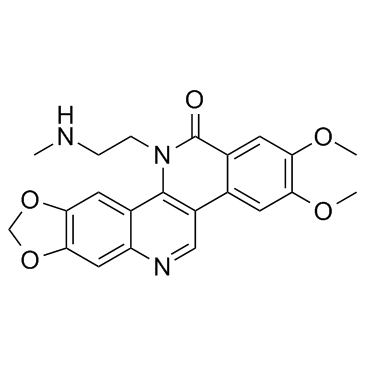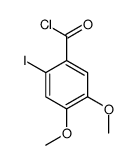Genz-644282

Genz-644282 structure
|
Common Name | Genz-644282 | ||
|---|---|---|---|---|
| CAS Number | 529488-28-6 | Molecular Weight | 407.41900 | |
| Density | N/A | Boiling Point | N/A | |
| Molecular Formula | C22H21N3O5 | Melting Point | N/A | |
| MSDS | N/A | Flash Point | N/A | |
Use of Genz-644282Genz-644282 is a non-camptothecin topoisomerase I inhibitor, used for cancer research. |
| Name | 8,9-dimethoxy-2,3-methylenedioxy-5-[2-(N-methylamino)ethyl]-5H-dibenzo[c,h]1,6-naphthyridin-6-one |
|---|---|
| Synonym | More Synonyms |
| Description | Genz-644282 is a non-camptothecin topoisomerase I inhibitor, used for cancer research. |
|---|---|
| Related Catalog | |
| Target |
Topoisomerase I |
| In Vitro | Genz-644282 is a topoisomerase I inhibitor. Genz-644282 shows potent activities against 29 human tumor cell lines with IC50s ranging from 1.8 nM to 1.8 μM[1]. Genz-644282 suppresses the PPTP cell lines, with IC50s of 0.2-21.9 nM, and the mean IC50 value is 1.2 nM[2]. Genz-644282 is potent at trapping Top1-DNA covalent cleavage complexes. Genz-644282 (0.1 μM) induces γH2AX foci in human colon cancer HCT116 cells and breast cancer MCF7 cells. Genz-644282 is cytotoxic on the CPT-resistant human cancer cell lines[3]. |
| In Vivo | Genz-644282 (1-4 mg/kg) is active when administered intravenously to the mice. Genz-644282 (2.7 mg/kg, i.v.) causes tumor growth delay (TGD) of 34 days in the human HCT-116 colon cancer xenograft, 27 days in the human HT-29 colon carcinoma xenograft and mice bearing the NCI-H460 human non-small cell lung carcinoma. Genz-644282 (2 mg/kg, i.v.) results in a TGD of 33 days in the human HCT-15 colon carcinoma xenograft, and 28 days in mice bearing LOX-IMVI melanoma. Moreover, Genz-644282 (1 mg/kg, i.v.) leads to 14 days of TGD in mice bearing the DLD-1 human colon carcinoma xenograft. Genz-644282 (1.7 mg/kg, i.v.) also produces a TGD of 23 days in mice bearing 786-O tumors and 33 days in NCI-H1299 human non-small cell lung carcinoma xenograft[1]. Genz644282 at maximum tolerated dose (MTD, 4 mg/kg) results in maintained complete responses (MCR) in 6/6 evaluable solid tumor models. Genz644282 (2 mg/kg) induces CR or MCR in 3/3 tumor models and causes objective regressions in 7 of 17 (41%) models, but there are no objective responses at 1 mg/kg[2]. |
| Cell Assay | Twenty-nine established human tumor cell lines are exposed to a concentration range of Genz-644282 in two-four independent experiments. Human tumor cell lines representing a range of histology and potential resistance mechanisms includ MIA PaCa-2, AsPC-1, BxPC-3, CFPAC-1, Hs766T and Capan-1 pancreatic cancers, MEL624, C32, Hs695T and SK-MEL-3 melanomas, NCI-H1299, NCI-H292, NCI-H1915 and SW900 non-small cell lung cancers, HCC1395, HCC1937, HCC202, Hs578T, T-47D and ZR-75-1 breast cancer, ACHN, 769-P, A-498, A-704, SW156, Caki-2 and TK-10 renal cancers and OVCAR-4 and OVCAR-5 ovarian cancers. Cells are plated at 4 × 103/well in 96-well tissue culture plates in 100 µL RPMI medium supplemented with 5% FBS and 12 concentrations of Genz-644282 from 0.1 nM to 10 µM, with each concentration tested in triplicate. Plates are incubated overnight at 37ºC in humidified air with 5% CO2. Plates are incubated with Genz-644282 at 37ºC with humidified air/5% CO2 for 72 hrs. After the incubation period, the test plates are read utilizing Cell Titer-Glo Luminescent Cell Viability Assay. Luminescence is measured with a Synergy HT plate reader utilizing the associated ineticalc software, Version #3.4. Luminescence data are converted to growth fraction by comparison to the luminescence for the untreated control for each cell line and IC50 and IC90 values determined from the graphical data. Each cell line is tested in t least two independent experiments[1]. |
| Animal Admin | Nu/nu mice are implanted subcutaneously with a 4 mm3 tumor fragment, and treatments are initiated when tumors reach 200 mm3. Compounds are prepared freshly prior to injection, with Genz-644282 is formulated in M/6 lactate, irinotecan in D5W (5% Dextrose, aqueous), gemcitabine in saline, and docetaxel in ethanol, Cremophor EL and saline. Genz-644282 is compared with irinotecan in experiments with the human HCT-116, HT-29, HCT-15 and DLD-1 colon carcinoma and 786-O renal cell carcinoma xenografts. Irinotecan is administered at 60 mg/kg/day by IV injection every fourth day for three injections. Genz-644282 is compared with docetaxel in the human CIH460 non-small cell lung carcinoma xenograft. Docetaxel is administered at 12, 16 or 20 mg/kg/day by IV injection on alternate days for three injections. Genz-644282 is compared with dacarbazine in the human LOX-IMVI melanoma xenograft. Dacarbazine is administered at 90 mg/kg/day by IP injection once daily for 5 days. Genz-644282 is administered at 1, 1.36, 1.7, 2.7 or 4.1 mg/kg/day by IV on alternate days 3-times per week for 2 weeks in all in vivo experiments[1]. |
| References |
| Molecular Formula | C22H21N3O5 |
|---|---|
| Molecular Weight | 407.41900 |
| Exact Mass | 407.14800 |
| PSA | 83.84000 |
| LogP | 3.05910 |
| Storage condition | 2-8℃ |
|
~92% 
Genz-644282 CAS#:529488-28-6 |
| Literature: Ruchelman, Alexander L.; Houghton, Peter J.; Zhou, Nai; Liu, Angela; Liu, Leroy F.; LaVoie, Edmond J. Journal of Medicinal Chemistry, 2005 , vol. 48, # 3 p. 792 - 804 |
|
~% 
Genz-644282 CAS#:529488-28-6 |
| Literature: Ruchelman, Alexander L.; Houghton, Peter J.; Zhou, Nai; Liu, Angela; Liu, Leroy F.; LaVoie, Edmond J. Journal of Medicinal Chemistry, 2005 , vol. 48, # 3 p. 792 - 804 |
|
~% 
Genz-644282 CAS#:529488-28-6 |
| Literature: Ruchelman, Alexander L.; Houghton, Peter J.; Zhou, Nai; Liu, Angela; Liu, Leroy F.; LaVoie, Edmond J. Journal of Medicinal Chemistry, 2005 , vol. 48, # 3 p. 792 - 804 |
|
~% 
Genz-644282 CAS#:529488-28-6 |
| Literature: Ruchelman, Alexander L.; Houghton, Peter J.; Zhou, Nai; Liu, Angela; Liu, Leroy F.; LaVoie, Edmond J. Journal of Medicinal Chemistry, 2005 , vol. 48, # 3 p. 792 - 804 |
|
~% 
Genz-644282 CAS#:529488-28-6 |
| Literature: Ruchelman, Alexander L.; Houghton, Peter J.; Zhou, Nai; Liu, Angela; Liu, Leroy F.; LaVoie, Edmond J. Journal of Medicinal Chemistry, 2005 , vol. 48, # 3 p. 792 - 804 |
|
~% 
Genz-644282 CAS#:529488-28-6 |
| Literature: Ruchelman, Alexander L.; Houghton, Peter J.; Zhou, Nai; Liu, Angela; Liu, Leroy F.; LaVoie, Edmond J. Journal of Medicinal Chemistry, 2005 , vol. 48, # 3 p. 792 - 804 |
|
~% 
Genz-644282 CAS#:529488-28-6 |
| Literature: Ruchelman, Alexander L.; Houghton, Peter J.; Zhou, Nai; Liu, Angela; Liu, Leroy F.; LaVoie, Edmond J. Journal of Medicinal Chemistry, 2005 , vol. 48, # 3 p. 792 - 804 |
|
~% 
Genz-644282 CAS#:529488-28-6 |
| Literature: Ruchelman, Alexander L.; Houghton, Peter J.; Zhou, Nai; Liu, Angela; Liu, Leroy F.; LaVoie, Edmond J. Journal of Medicinal Chemistry, 2005 , vol. 48, # 3 p. 792 - 804 |
| Precursor 8 | |
|---|---|
| DownStream 0 | |
| Benzo(C)(1,3)benzodioxolo(5,6-H)(1,6)naphthyridin-13(12H)-one,2,3-dimethoxy-12-(2-(methylamino)ethyl) |
| UNII-717I541I2R |
| Genz-644282 |
![12-(2-(benzyl(methyl)amino)ethyl)-2,3-dimethoxy-[1,3]dioxolo[4',5':4,5]benzo[1,2-h]benzo[c][1,6]naphthyridin-13(12H)-one structure](https://image.chemsrc.com/caspic/404/847573-86-8.png)



![8-CHLORO[1,3]DIOXOLO[4,5-G]QUINOLINE structure](https://image.chemsrc.com/caspic/122/59134-89-3.png)
![[1,3]DIOXOLO[4,5-G]QUINOLIN-8(5H)-ONE structure](https://image.chemsrc.com/caspic/247/154504-43-5.png)
![4-[[2-(N-benzyl-N-methylamino)ethyl]amino]-6,7-methylenedioxyquinoline structure](https://image.chemsrc.com/caspic/204/847573-69-7.png)
![N-(6,7-methylenedioxyquinolin-4-yl)-N-[2-(N-benzyl-N-methylamino)ethyl]-2-iodo-4,5-dimethoxybenzamide structure](https://image.chemsrc.com/caspic/035/847573-78-8.png)